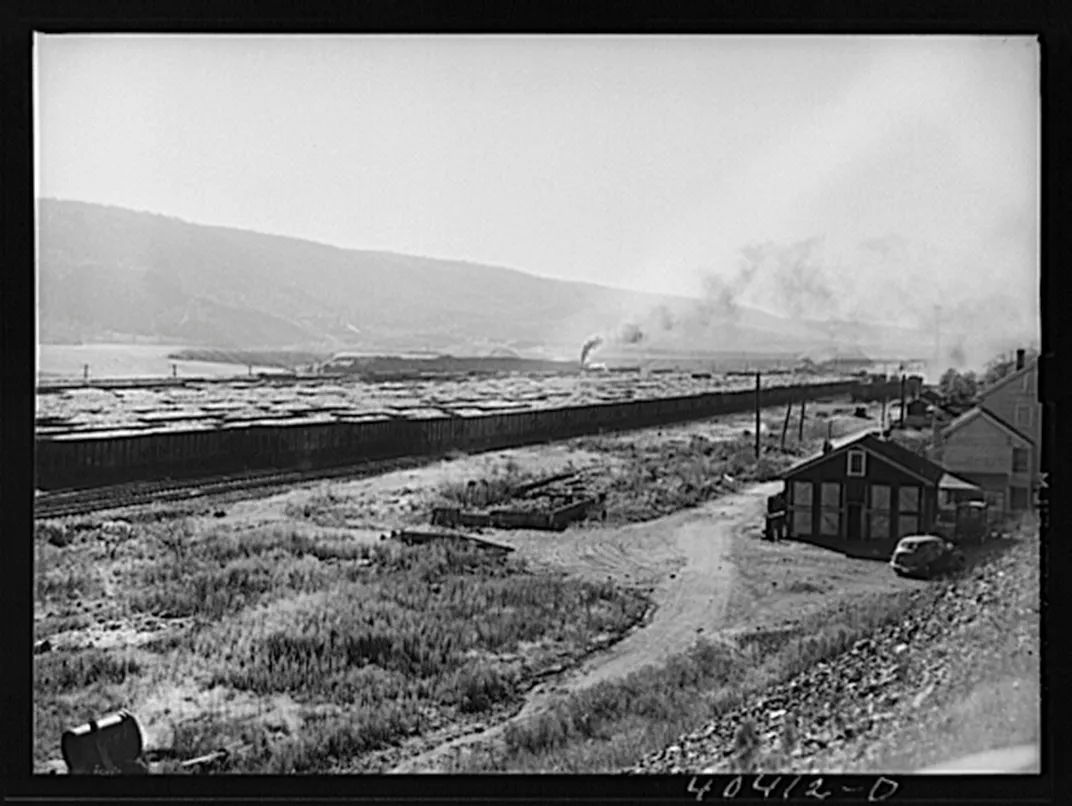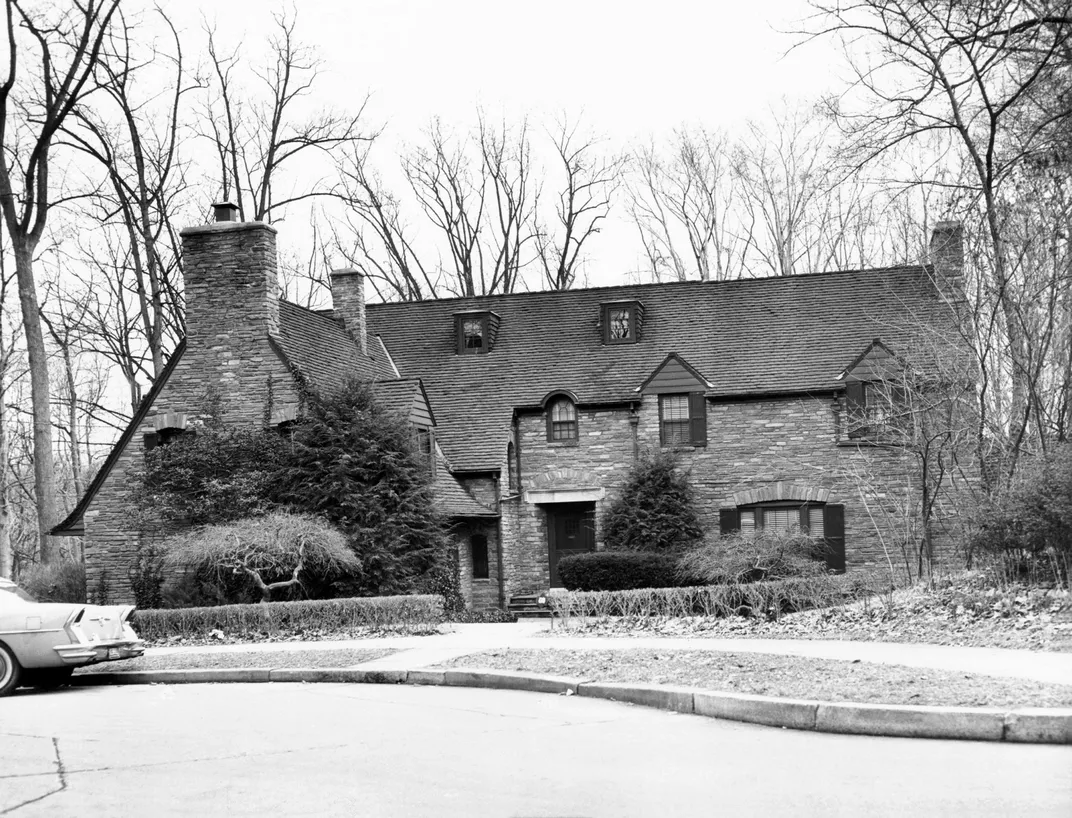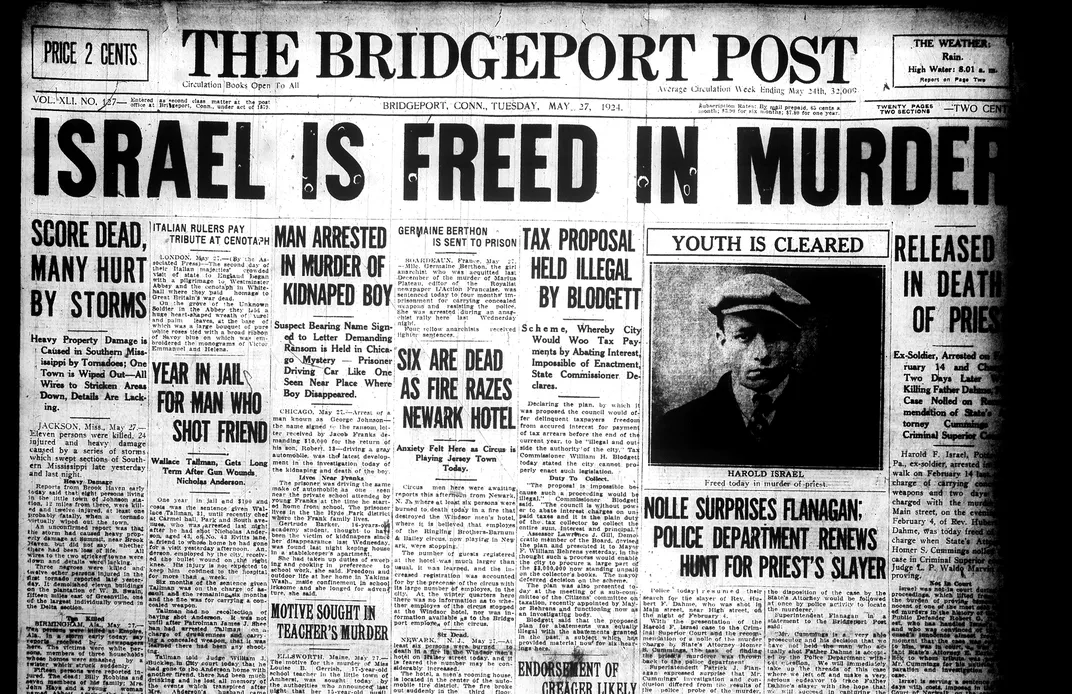The Suspect, the Prosecutor, and the Unlikely Bond They Forged
New evidence shows that Homer Cummings, who would later be FDR’s attorney general, rescued an innocent man accused of murder
/https://tf-cmsv2-smithsonianmag-media.s3.amazonaws.com/filer/ea/97/ea97555d-4d95-45d7-bdcc-9594c88f12a0/janfeb2017_c05_homercummings-wr.jpg)
As attorney general of the United States in the 1930s, Homer Cummings announced the capture of Bruno Hauptmann in the kidnapping and murder of the Lindbergh baby. He built Alcatraz, the island prison. In the time of John Dillinger, Pretty Boy Floyd and Bonnie and Clyde, he consolidated federal investigative units into what became the FBI. He fought incessant battles for New Deal legislation. And he was instrumental in one of the century’s great scandals, President Franklin D. Roosevelt’s disastrous attempt to pack the Supreme Court. In fact, Cummings was chief architect of the plan, which was widely condemned; its true purpose of manufacturing a friendlier Supreme Court was buried under talk of judicial efficiency.
Within the legal profession, though, Cummings is remembered for what he did as a county prosecutor in the 1920s. His performance in a Connecticut murder case so moved Felix Frankfurter that the renowned Supreme Court justice declared it “will live in the annals as a standard by which other prosecutors will be judged.” And so it has, providing a historical counterpoint to the present day, when stories abound of prosecutors who have lost their way, who do anything to win a conviction, who place politics above principle.
But what happened in that case is only Act I in an extraordinary drama. Act II, untold until now, has been sitting in an archive at the University of Virginia for more than 40 years, tucked among 171 linear feet of Cummings’ shelved papers.
ACT I
Homer and Harold: 1924
Connecticut, in the 1920s, did not hang the condemned by having him fall. The executioner had the condemned stand on an iron plate, noose around his neck, to be yanked skyward courtesy of a contraption called the “upright jerker.” Why Connecticut eschewed a simple act of gravity for a system of weights and pulleys is not entirely clear (the patent obtained by an earlier warden might explain it), but the upright jerker loomed over the proceedings when, on May 27, 1924, Homer Cummings entered a Fairfield County courtroom and argued before the Honorable Waldo Marvin.
If your Honor please: I would like to call to your attention this morning the case of State versus Harold Israel.
Inside a courthouse that looked like a castle, Cummings spoke for the next hour and a half. He was a polished orator. He had graduated from Yale, and had debated against Harvard.
On the 15th day of February, 1924, this accused was bound over to this court by the City Court of Bridgeport on a charge of murder...
Cummings had been the Fairfield state’s attorney—the chief prosecutor, appointed by judges—for the past ten years. Now 54, he had nursed political aspirations since he was in his 20s. Three times he had run for Congress or the U.S. Senate and lost. Four years before, as chairman of the Democratic National Committee, he had delivered the keynote at the party’s national convention in San Francisco. The Chicago Tribune described him as “tall, rotund, but not grossly rotund” and “bald but not grotesquely bald.” His blue eyes were now framed by gold pince-nez glasses clipped to his long nose.
... in the first degree, growing out of the death of Reverend Hubert Dahme, pastor of St. Joseph’s....
The victim was a Catholic priest in a city full of Catholics. Father Dahme, a 56-year-old German native, had built a convent and a school in Bridgeport. The Easter before, he had laid the cornerstone of a $100,000 church. Twelve thousand mourners packed the funeral.
He had been shot while taking a stroll downtown on February 4. At Main and High, amid a stretch of grand theaters, a man had approached Dahme from behind and fired one bullet from a .32-caliber revolver into his head at 7:45 p.m., as streetlights burned and theatergoers scurried about. Minutes before, Ethel Barrymore had passed by on her way to the New Lyric, where she was performing in The Laughing Lady.
On account of the tragic nature of this murder, the well-frequented spot where it occurred and the prominence of the victim, an unusual amount of public interest was aroused....
This was, in cop parlance, a heater case, the pressure to solve it great. “The most shocking crime of its kind in the history of Bridgeport,” the mayor called it. Rewards totaling some $2,500 were offered for the killer’s capture. Still, days passed without an arrest. A week after the shooting, a police officer in Norwalk, west of Bridgeport, saw a young man he thought to be acting strangely. It was after 1 a.m. The man identified himself as Harold Israel. He said he had neither money nor a place to sleep and was making for home, in Pennsylvania. Police found in his possession a .32-caliber revolver.
Israel was arrested for having a concealed weapon and hustled to city court, where he was fined $50 and sentenced to jail. When a Bridgeport Times reporter learned of the arrest (.32-caliber? Hmm), the newspaper contacted a Bridgeport police captain, who dispatched two detectives to interview Israel and two other detectives to examine the gun, which, they discovered, had four chambers loaded—and one empty.
Israel told police that on the night of the murder, he was at the movies, alone. The police considered him an “arch liar,” the Bridgeport Times reported. Israel’s former landlady called him “a rather queer sort of fellow.” The paper instructed readers: “If you have any information or are of the opinion that you saw a suspicious character that may be Harold Israel,” contact police. “You may help to solve the most brutal murder in the history of Bridgeport.” As Israel was being questioned, eyewitnesses came in and implicated him. The interrogation continued until, after 28 hours, he confessed.
Three weeks after Father Dahme’s death, the coroner summarized the evidence against Israel:
A waitress said she had seen him walk past her restaurant minutes before the shooting took place a block away.
Four witnesses said they had seen him after the shooting, fleeing the scene.
A ballistics expert said the bullet recovered from Father Dahme’s head had been fired from the revolver found on Israel.
And then there was Israel’s confession, oral and written.
The case against the accused seemed overwhelming. Upon its face, at least, it seemed like a well-nigh perfect case.... The evidence had been described by those who believed in the guilt of the accused as “100 percent perfect.”
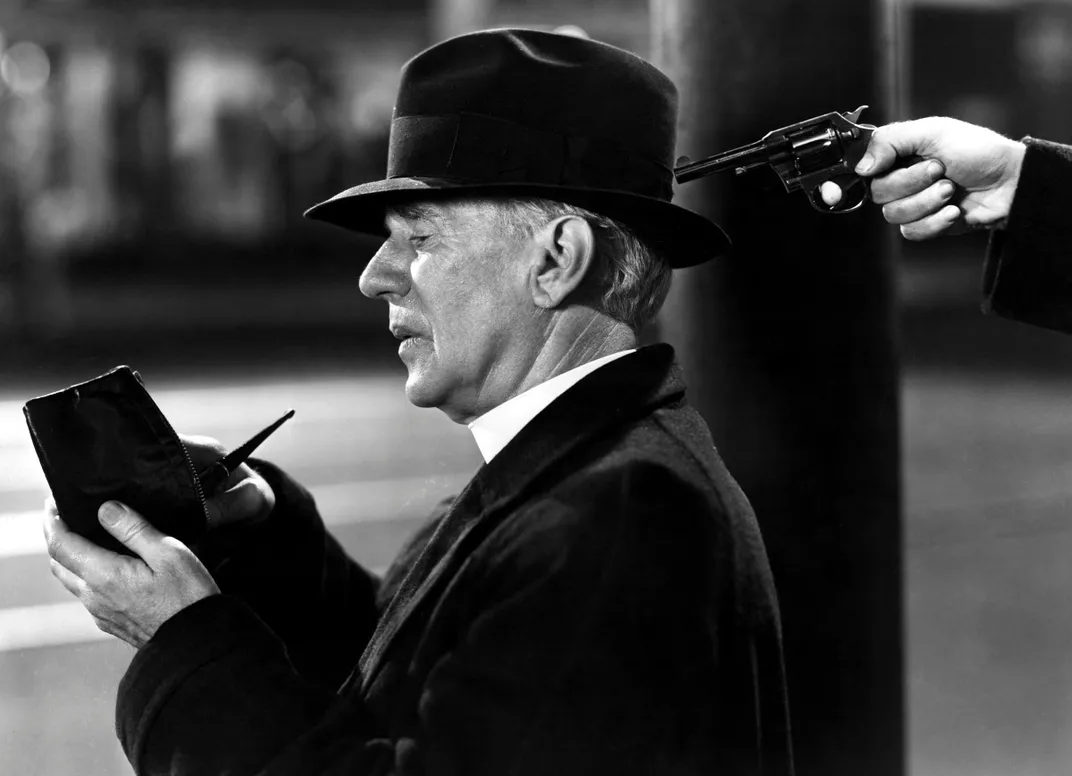
In 1924, the criminal justice system’s flaws were not understood in the way they are today, now that DNA has exposed so many wrongful convictions. Little had been written about false confessions, mistaken eyewitnesses or bogus forensics. The year before Israel’s arrest, Learned Hand, an esteemed federal judge in New York, dismissed the very idea that an innocent person could be convicted, calling it “an unreal dream.”
Cummings took close to half an hour to describe the evidence pointing to Israel’s guilt. Then, unexpectedly, he said:
Despite these facts, however...
When the lives of Harold Israel and Homer Cummings intersected in 1924, the two men came from different generations and worlds.
Israel, Cummings’ junior by more than 30 years, was born in 1903 in Mount Carmel, Pennsylvania, a small town in coal country. He was the youngest of at least five kids, according to 1910 census records. His father, John, was a miner. Harold’s mother, Wilhelmina, called Minnie, was born in Germany. She died at 39, when Harold was 5. “Exhaustion,” her death certificate said. Later, Harold would be unable to summon her maiden name. One descendant says: “Harold was literate. Granted, I don’t think he graduated from high school. My dad thinks he got kicked out of the house and kind of sold off to another family to help them. They were poor as well.” Harold grew up to be thin and quiet.
When arrested in Connecticut, Israel filled in some of his story, saying he had served in the Army, stationed in Panama. After his discharge he had made his way to Bridgeport to join a friend from the military. Israel had about $300 when he arrived. When the money was spent, he struck out for home.
Homer Cummings, an only son, was born in 1870, to a life of advantage. His mother, Audie, was a Knickerbocker, descendant of a well-known line of Dutch settlers in New York. His father, Uriah, was a successful inventor, historian and specialist on the American Indian. He owned a cement mill in Akron, New York, capable of producing 400 barrels a day. His family had come to Massachusetts from Scotland in 1627. Homer grew up in Buffalo playing baseball, tennis and lacrosse, his mother “talented and beautiful,” his father “one of the kindest men in the world,” he told the Buffalo Evening News. His neighbor was an eminent architect, his friends were future physicians and lawyers.
After graduating from Yale in 1891, Homer remained to study law, graduating again in 1893. Four years later, when he was 27, he married Helen Woodruff Smith, daughter of a New York banker. The couple wed aboard the banker’s 108-foot yacht, a mile out on Long Island Sound, with orchestra on deck and pleasure vessels all around, cannons booming, the bride’s veil pinned with a diamond star, the wedding ring a constellation of diamonds, emeralds, rubies and sapphires.
Homer’s could have been a gilded life. But in his 20s he switched from Republican to Democrat. In Connecticut, “Democrats were so scarce that one who could sign his name, made a habit of blowing his nose and had not murdered his mother automatically became a party leader,” read a political report from that time. Cummings, having not murdered his mother, became a party leader. He failed to win national or state office, but did win three terms as mayor of Stamford, a Republican stronghold. He was 30 when first elected.
As mayor, Cummings was a progressive, pursuing safety regulations, investigating slaughterhouses, breaking the local utility’s monopoly. In 1905 he allowed several Italian societies to hold a Sunday picnic—beer, fireworks and all—in a prosperous part of town. “When it became known that Mayor Cummings had licensed a Sunday picnic the Puritanical element of Stamford was horrified,” the New York Times reported.
After ten years of marriage and one child, a son, Homer and Helen divorced. When the couple had wed, the Times described him as “one of the most brilliant young lawyers and politicians in the state of Connecticut.” Now, the paper said he had been a “struggling young lawyer” when the two joined fortunes, and that “his rise, especially in politics, is regarded as due largely to his wife’s efforts.”
Then the publicity got worse. A young man sued Helen for breach of promise of marriage, saying that when she was married—and he was 18—they had begun an affair. Love letters were passed. A newspaper published dozens of them. But in 1911, when the case was tried, the jurors found for Helen, unable to discern in her many letters any promise of marriage.
When Homer stood in that Connecticut courtroom in 1924 in the Harold Israel case, he was 13 years removed from those mortifying newspaper stories—and remarried, to the heiress of a silk fortune.
Despite these facts, however...
Some people had doubts about Israel’s guilt, Cummings told the court. So Cummings had elected to investigate on his own. He interviewed every witness. He stood where they stood when they saw what they’d seen. He interviewed Israel, in the presence of Israel’s public defender. He studied the police reports, consulted experts and walked the crime scene.
It goes without saying that it is just as important for a state’s attorney to use the great powers of his office to protect the innocent as it is to convict the guilty.
Cummings told the court what he had learned:
At the waitress’s restaurant, there was a glass partition inside the front window. The two panes were separated by a couple of feet, with a light between. These double windows created distortion, making it “very difficult” to make out the features of any person on the other side. He also noted that when he had interviewed the waitress, “she was by no means certain of her ground.”
The prosecutor also found reason to doubt the four witnesses who reported seeing Israel fleeing. One said the shooter had used a black pistol that did not shine. Israel’s revolver was nickel-plated, Cummings told the judge. Under electric lights, it likely would have glinted. Cummings had recreated the conditions—the distance, the lighting—reported by two other witnesses, and said he could not even identify a person he knew well, much less a stranger. The fourth witness’s account suffered from a “tinge of the imaginative” and changed on second telling.
Instead of relying on the single ballistics expert used by police, Cummings asked six others to compare the mortal bullet with Israel’s gun. These experts had studied at Harvard, Yale, MIT and had worked for Winchester, Remington, the New York City Police Department. All six concluded that Israel’s gun had not fired that bullet.
Cummings had asked three physicians to examine Israel two days after his confession. They found him to be a docile man, particularly vulnerable to suggestion, physically and mentally spent, incapable of saying anything dependable. Later, his condition restored, he reasserted his innocence, saying he’d confessed just to get a rest. All three physicians believed his confession held no value.
As for Israel’s alibi, the theater he claimed to be in had been showing four short movies on a loop. Israel had described what was showing at 7, when he entered, and at 9, when he left—and the theater’s manager had confirmed his account.
“I do not think that any doubt of Israel’s innocence can remain in the mind of a candid person,” Cummings told the judge. The state’s attorney said he wished to enter a nolle prosequi—a Latin term used to mean, “We shall no longer prosecute.” He wanted to drop the murder charge.
Judge Marvin commended Cummings for his “painstaking care” and granted his request.
In years to come, writers would describe Israel’s reaction in court to the judge’s order. One described his “quivering lips,” another his bursting “into tears,” yet another his “hysterical joy.” Alas, these writers suffered their own tinge of the imaginative—for Israel was not in court that day. He did not see his life being saved by a prosecutor who blew up the police’s case, Bridgeport’s daily newspapers reported. Israel was apprised later in jail, where he was finishing his time for carrying a concealed weapon.
Upon hearing the news he said simply, “That’s good. It came out right,” the Bridgeport Times reported, adding: “Israel is going back to Pottsville, Pa. He will not be found again, he says, carrying concealed weapons and he is going to try to be a hard working boy living at home among his friends and neighbors.”
Within a few days, friends rounded up the money to pay Israel’s outstanding court costs. He was then taken to the train station and sent home.
Homer: 1924-1946
A prosecutor who bucked the police and backed a suspect—a man passing through, a man without means—seemed to invite recrimination. But immediately after the hearing, the police superintendent said his department accepted Cummings’ conclusion “without question.” The local press lauded Cummings’ “brilliant presentation” and “masterly analysis.” A law journal published his entire statement. In time, it became required reading for lawyers in the U.S. Department of Justice. After he stepped down as prosecutor later that year, the Fairfield County Bar held a banquet in his honor.
Nine years after Learned Hand mocked wrongful conviction as “an unreal dream,” Yale law professor Edwin Borchard published Convicting the Innocent, a book with 65 instances of such. The Israel case was not among the 65 because he was never convicted, but Borchard cited it in his introduction to note the danger of false confessions.
Cummings, in his mid-50s, settled into private practice, focusing on corporate law at Cummings & Lockwood, a firm he had formed with a friend. In 1932, he attended the Democratic National Convention as a delegate and delivered a stirring seconding speech for Franklin Delano Roosevelt, who, once elected president, named him attorney general. Cummings held the post for nearly six years.
The historian Arthur M. Schlesinger called Cummings “a man of genuine ability, wily in the law, experienced in politics, courageous and tough.” Other historians questioned Cummings’ legal acumen while noting his “ferocious appetite for bureaucratic power” and accused him of turning Justice into a “patronage reservoir.” Although he expanded the Justice Department’s reach, he faced criticism for not expanding it enough. When he refused to apply a federal kidnapping law to lynchings, Walter White, head of the NAACP, wrote Cummings:
My dear Mr. Attorney General:
We have read with interest the Associated Press dispatch of December 21 that you ordered the Bureau of Investigation of the Department of Justice to find a cloak which Mrs. Campbell Pritchett lost at a party given by you and Mrs. Cummings.
Has the Bureau found Mrs. Pritchett’s cloak yet? If so, may we inquire if it would be possible for you to assign the operatives thus freed by completion of that job to investigate the interstate kidnapping and subsequent lynching of Claude Neal.
His personal life continued to make news. In the late 1920s, his second marriage ended in a Mexican divorce. His third marriage, to Cecilia Waterbury, was, forgive the cliché, charmed. In 1931, Homer and Cecilia spent two months touring the Mediterranean. Homer wrote a travel memoir, The Tired Sea, describing how the couple picnicked in Beirut, survived high seas in Malta, and in Jerusalem dined with Gene Tunney, the famous boxer and one of Cummings’ closest friends. In Washington, Cecilia’s “quick wit and keen intelligence” cut “a bright path across the capital’s social scene,” the New York Times reported.
At the beginning of 1939, Cummings stepped down as head of the Justice Department.
Seven months later, Cecilia died, leaving Homer, 69, alone.
Act II
Homer and Harold: 1946-1956
On July 26, 1946, a Friday, at a little before 5 in the morning, Harold Israel got on a train in Pottsville, Pennsylvania.
He rode to Philadelphia, got off and hopped another train to Washington. At about 11 a.m. he arrived in the capital, then made his way to 1616 K Street Northwest, a few blocks from the White House. There, he prepared to see Homer Cummings for the first time in 22 years.
Israel was now 43. He did not know what this was about. All he knew was that a special agent with the FBI had contacted him to say that Cummings wished to meet.
Cummings was now 76. After leaving the Justice Department he had returned to private practice, working in Washington, where he owned an English Tudor with a library and a butler’s pantry. By now he was remarried, to Julia Alter, a newspaper writer.
Since Connecticut, contact between Cummings and Israel had been fleeting. In 1941, they had exchanged brief letters. “Dear Friend,” Israel wrote first. “Just a few lines to let you know that I am well and that this will leave you the same. I guess you think that I have the nerve to write to you for what you have did for me. But you see I have to write to some one.” Israel’s letter said he was out of work and “on the relief.” He had little to live on and wasn’t sure what to do. Cummings replied a week later, saying how pleased he was to hear from Israel. But, his letter said, “I do not know at present what I can do.”
Five years later, in the spring of 1946, Cummings saw an opportunity to help. He received a telephone call from a filmmaker, Louis de Rochemont, who said he was considering producing a movie about the Israel case for 20th Century Fox. The filmmaker asked: Do you know where Israel can now be found?
When Cummings was attorney general, his FBI director was J. Edgar Hoover. Hoover was still there (and would be for decades to come), so Cummings reached out, asking for information on the man he had once saved. On May 27, 1946, Hoover wrote to share what his agents had learned. Israel was living in Gilberton, another Pennsylvania coal town. He was working for the Philadelphia and Reading Coal and Iron Company, where he was “well accepted and highly regarded.” He had two boys, ages 19 and 13. The older one was serving in the Navy.
Cummings wrote back, pressing for details. Was Israel’s wife alive? How much was he paid? What was his house worth? Hoover answered: Israel’s wife of 20 years, Olive Mae, was alive and living with him. He worked seven days a week, for $60 per week. His house, an “extremely modest” duplex on an unpaved street, was worth about $700. He oiled machinery (“a good, dependable employee”); was a “constant attendant at the Gilberton Methodist Church of which he is a Trustee”; and was a “family man...not known to ever frequent the tap rooms.”
Thus informed, Cummings began negotiating with 20th Century Fox. With the help of his firm, he researched trusts, bonds and taxes.
When Israel showed up in his office on July 26, Cummings shared the results of his labor. He told Israel that the film company was paying him $18,000 for the rights to his story. Cummings had set aside $6,500 for Israel’s anticipated tax hit. He had invested $8,995 in U.S. savings bonds in Israel’s name. The rest, $2,505, was made out in a check, which Homer handed to Harold.
In today’s dollars, that $18,000 would be worth about $222,000. Cummings also negotiated a deal for his own life rights, securing $10,000—which he donated to the George Washington University Hospital.
Israel, check in hand, left for Gilberton.
A few days later, Cummings received a letter from Olive Israel, describing what happened when Harold’s train pulled in. “When we met him at the station and he got in the car I said ‘Are you O.K. and what did Mr. Cummings want you for.’ He had a big smile and said, ‘I’m all right and we have plenty of money.’ I said ‘how much.’ When he told me I almost fainted. I couldn’t believe him so he told them to stop the car and he showed me the check first, then the paper with all the bonds....
“We can’t begin to thank you enough for what you have done for us,” Olive wrote. Harold, she said, “has been a perfect husband & father....He has worked hard and was always willing to do anything.” Now he could afford to fix up their house. Now he could do something about their 13-year-old Ford.
Even before this, Olive wrote, Harold had told her how much Cummings meant to him. “To him Mr. Cummings you are next to God. He worships you. He said he would trust you more than anybody in this world.”
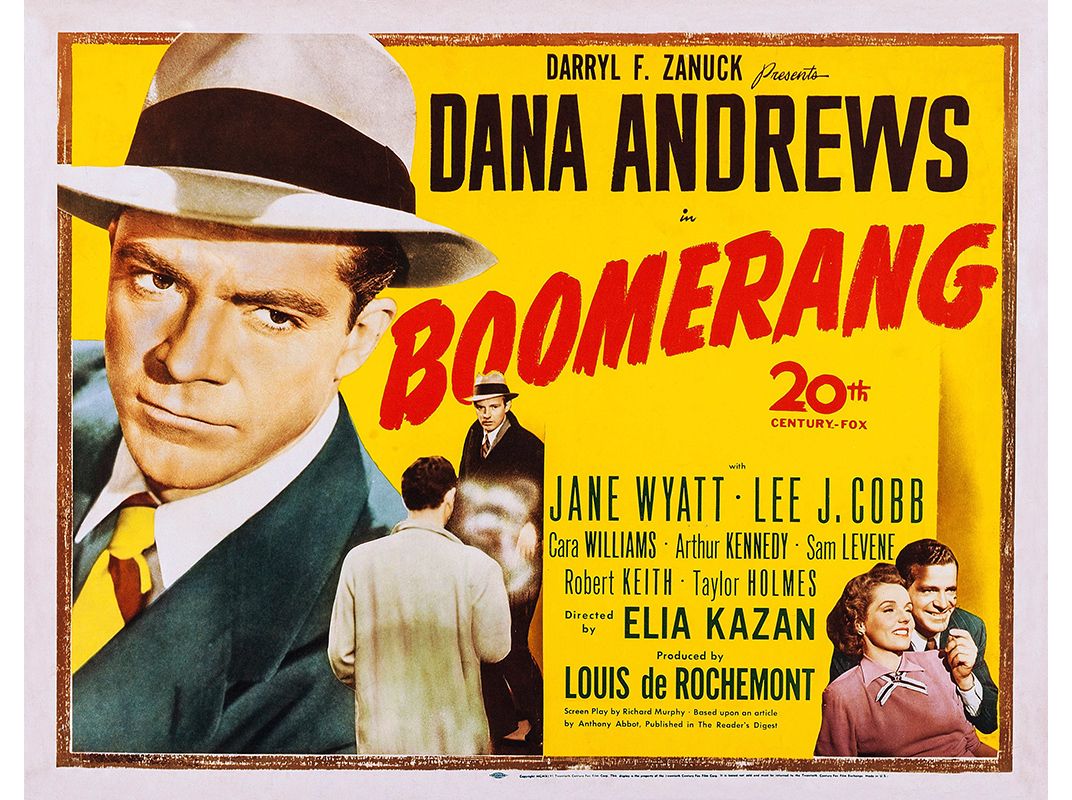
In Washington, Israel had told Cummings he’d been hurt by his depiction in a recent Reader’s Digest story reconstructing the Connecticut case. The story had referred to him as a “penniless tramp” and a “vagabond.” Cummings knew the story’s author, Fulton Oursler. (He later wrote The Greatest Story Ever Told, the best-selling biography of Jesus.) Oursler was involved in this movie. So Cummings wrote to him, saying Israel was a respectable, hard-working family man with a “distinct sense of pride and self-respect.” Israel was never a tramp, Cummings wrote, and he was “leaning heavily” on Oursler to ensure the movie did not cast him so.
In August, Olive wrote Cummings to say Harold had bought a 1940 Chevrolet for $800 and planned to build a bathroom in their house. They had ordered a refrigerator because food didn’t keep long in their icebox. They also hoped to get a porcelain sink for the kitchen, dental care for Harold and Olive and some new clothes. “Mr. Cummings I don’t think it is extravagant to try to buy these things that we wanted all our life and could never get until you made it possible, do you?” she wrote.
Cummings wrote back a few days later, saying the purchases seemed “entirely justified. I hope that you and your family will derive great comfort and happiness from these expenditures....When I last saw Harold he spoke of the need of dental work. This, I think, is very important, as health in large measure depends upon well-looked-after teeth.”
Olive replied to this letter, and Homer replied to hers, and Olive returned that one, and over months, then years, a few letters became dozens. The correspondence grew less formal, the families sharing ailments (Homer, a blood clot in his left arm, Harold, a bad cold) and talk of weather (“it is supposed to snow 5 inches today”). Olive provided updates on the couple’s two sons, on Freddie getting married (“I’d rather if he waited until he is older but...I guess if they love each other that’s all that matters”) and having a daughter (“I don’t think we could have picked a prettier baby if we tried to pick from a million babies”), and then another daughter, and on Bobby making JV basketball, then varsity football and baseball, then joining the Army and serving in Germany, then France.
Harold and Olive sent cards, and Homer sent gifts: ties for the men; perfume for Olive; a sweater outfit for Freddie’s first daughter; a coverlet crocheted by Homer’s wife for Freddie’s second daughter. Olive and Harold would ask for advice—on legal or financial matters, or about their sons’ career prospects—and Homer would oblige.
In the letters, the difference in their circumstances is not remarked upon. Homer mentioned vacations in Florida and golfing in North Carolina. Olive described Harold’s routine of waking at 6, working until 2, coming home to pick coal or maybe work on his car, then, at night, listening to the radio and eating potato chips. On some Monday nights, they went to the midget auto races.
In early 1947 the movie was released. Boomerang! was directed by Elia Kazan, later of On the Waterfront fame. It made the prosecutor a young man—less established, more vulnerable to pressure—and introduced corrupt political forces for added drama. But it remained largely faithful to fact and depicted the accused sympathetically. In the movie, as in real life, the priest’s murder was never solved. (In Bridgeport, some police continued to believe Israel was guilty.) Homer called it “rather stirring” and “essentially sound.”
In time, the friendship moved beyond letters. Harold and Olive invited the Cummingses to visit—and in the summer of 1947, Homer and Julia set out for Pennsylvania. The story of how Olive prepared for their arrival—of how determined she was to make a good impression—would be told in the Israel family for decades. Harold and Olive had a small mutt that was getting up in years. Olive worried that its coat was too gray. So she kicked everyone out of the house and dyed the dog’s fur.
In 1952, Olive wrote that work for men in Gilberton had become slack, with coal operations shutting down. She tried working in a factory, sewing cuffs on shirts, but couldn’t take the smell of oil and “everybody grabbing, hurrying.” When Homer asked about the bonds, Olive said they had spent all of the money before the bonds matured. Homer told her he understood: The family had been under a lot of pressure. In Christmases to come, he would send especially nice gifts and, on occasion, money.
In 1955, Julia Cummings, Homer’s fourth wife, died. She was 49. Her obituary said she had suffered from high blood pressure. His son had died two years before.
In July 1956, Homer exchanged letters with Harold’s family one last time. In September he died at home, at the age of 86.
His house in Washington, the English Tudor, was sold the following January. The buyer was the country’s new vice president, Richard Nixon.
Epilogue
Homer and Harold: 1956-Today
In Connecticut, Homer Cummings’ name is still attached to Cummings & Lockwood, which now has 70 attorneys in six offices. A park in Stamford, on Long Island Sound, is named for him. People go there to play tennis or picnic or watch Fourth of July fireworks.
Cummings’ name is also on an award, given to a Connecticut prosecutor who exemplifies his principles. Kevin Kane, the chief state’s attorney of Connecticut, says the award helps “make sure that we don’t forget what our role is”—to do justice and to represent all the people. In 2008, Kane became convinced that two men arrested in the murder of a well-known energy scientist were innocent; he went into court and moved to have the charges dismissed. “And I did think during that, ‘What would Homer Cummings have done with a case like that?’”
Harold died in 1964, at the age of 60. It was winter, with snowdrifts piled up to car windows, but the coal company pulled out its heavy equipment and plowed roads all the way up to the house so mourners could visit and view Harold’s body in the parlor. “They had a good crowd there,” says Harold’s granddaughter Darlene Freil.
Harold and Olive had six grandkids and 13 great-grandkids, in a family tree that continues to grow.
Darlene remembers that, quiet as Harold was about all he’d been through, Olive never tired of talking about Homer Cummings. Olive had a keen sense of legacy. She often told her family: If things had gone differently in Connecticut, none of you would be here.
This story is published in collaboration with the Marshall Project and includes reporting by Lisa Mullins and Lynn Jolicoeur of WBUR-FM in Boston, a National Public Radio affiliate.
Related Reads
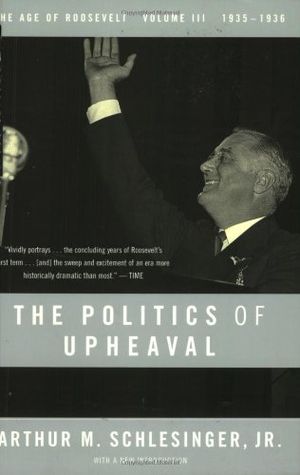
The Politics of Upheaval: 1935-1936, The Age of Roosevelt
